List of ironclad warships of France
France built a series of ironclad warships between the 1850s and 1890s; these began with the Dévastation-class ironclad floating batteries built during the Crimean War, which presaged Gloire, the first sea-going ironclad to be built by any navy.
Broadside ironclads[]
- Gloire class 5,603 tons.[1]
- Couronne (1861) 5,983 tons – hulked 1910.[1]
- Magenta class 6,715 tons.[1]
- Provence class 5,700 – 6,122 tons.[1]
- Provence (1863) – stricken 1884.[1]
- Héroïne (1863) – hulked 1894.[1]
- Flandre (1864) – stricken 1886.[1]
- Savoie (1863) – stricken 1888.[1]
- Magnanime (1864) – stricken 1882.[1]
- Surveillante (1864) – stricken 1890.[1]
- Valeureuse (1864) – stricken 1886.[1]
- Gauloise (1865) – stricken 1883.[1]
- Revanche (1865) – BU (broken up) 1893.[1]
- Guyenne (1865) – stricken 1882.[1]
- Belliqueuse (French: Belliqueuse) (1865) 3,717 tons – expended as a target 1886.[1]

Gloire
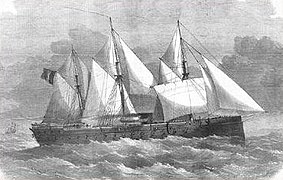
La Gloire

Invincible in 1860

Couronne in 1861

Magenta and Napoléon III

Solférino in 1861
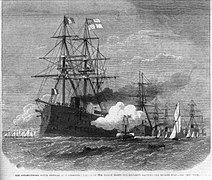
Solférino

Guyenne class in 1865

Belliqueuse in 1865

Normandie in 1870
Central battery ships[]
- Alma class (French: Classe Alma) 3,513–3,828 tons.[1]
- Océan class 7,580/7,775 tons.[1]
- La Galissonnière class (French: Classe La Galissonnière 4,585–4,645 tons.[1]
- La Galissonnière (1872) – stricken 1894.[1]
- Triomphante (1877) – sold 1903.[1]
- Victorieuse (1875) – hulked 1900.[1]
- Friedland (1873) 8,850 tons – stricken 1902.[1]
- Richelieu (1873) 8,984 tons – sold 1901, sank in the Bay of Biscay after sale.[1]
- Colbert class 8,750 tons.[1]
- Redoutable (1876) 9,224 tons, first warship in the world to use steel as the principal building material – stricken 1910.[1]
- Dévastation class 10,450 tons.[1]
- Dévastation (1879) – BU 1922.[1]
- Courbet (1882) ex-Foudroyant – stricken 1910.[1][2]
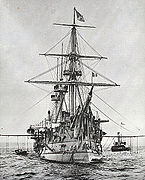
Océan in 1870

Océan
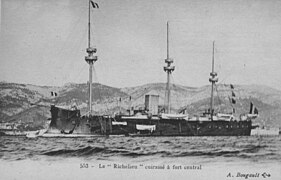
Richelieu

Colbert

Dévastation

Redoutable

Courbet
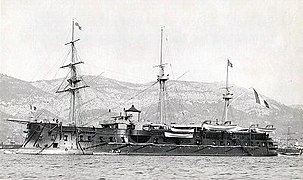
Colbert

Triomphante of the La Galissonnière class
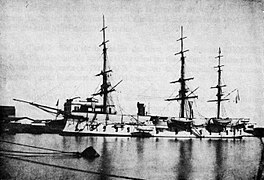
Galissoniére - 1882 - Port Said

Victorieuse - 1886 - Algiers
Barbette ships[]
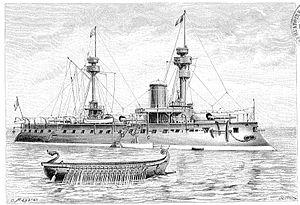
- Amiral Duperré (1879) 11,030 tons. Though this ship was designed for sail as well as steam power, her sails were removed before completion.[3] – stricken 1909.[1]
- (French: Classe Bayard) 5,915–6,260 tons.[1] Smaller versions of Amiral Duperré, with full sail power.[3]
- Vauban class (French: Classe Vauban) 6,112 tons. Improved Bayards.[1]
- Duguesclin (1883) – stricken 1904.[1]
- Vauban (1882) – stricken 1905.[1]
- Amiral Baudin class 11,720 tons,[1] the first French sea-going battleships without any sail power.[4]
- Amiral Baudin (1883) – hulked 1909.[1]
- Formidable (1885) – stricken 1911.[1]
- Terrible class (French: Classe Terrible) or Indomptable class, 7,530 tons.[1] Small battleships based on the Amiral Baudin, and intended for operating in the Baltic in case of war with Germany.[3] The British sometimes considered these to be sea-going battleships,[5] and sometimes coastal service warships.[2]
- Hoche (1886) 10,820 tons, turrets & barbettes – target 1913.[1]
- Marceau class 10,558–10,810 tons.[1]
- Charles Martel class 10,600–10,650 tons, slightly enlarged Marceaus.[6]

Amiral Duperré

Formidable testing a balloon

Neptune

Magenta

Marceau

Bayard

A painting by Paul Jazet (1848–1918), featuring a Vauban-class battleship

Bayard in Pord Said
Floating batteries[]
- Dévastation class built for the Crimean War 1,600 tons.[1]
- Palestro class 1,508–1,539 tons.[1]
- 1,412-1.490 tons.[1]
- 1,426–1,589 tons.[1]
Casemate ironclad[]
- Rochambeau (1865) ex-USS Dunderberg 7,800 tons, purchased 1867 – stricken 1872.[1]
Coastal defense ships[]
- (1865) barbette ship ram 2,433 tons – stricken 1890.[1]
- Onondaga (1863) ex-USS Onondaga 2,551 tons, purchased 1867 – stricken 1904.[1]
- 3,532 tons.[1]
- ,1st Class Coastal Battleship, 5,765–5,871 tons.[1]
- Furieux (1883) barbette ship 5,925 tons. Similar to Tonnant for the same reasons.[3] – stricken 1913.[1]
- Tempête class, 2nd Class Coastal Battleship, 4.635-4,793 tons.[1]
- (French: Tonnant) (1880) barbette ship 5,010 tons. Originally intended to be similar to Tempête, but redesigned as a small battleship with increased freeboard and a gun at each end in barbettes.[3] – stricken 1903.[1]
- Bouvines class 6,681 tons.[1]
- 6,476 tons.[1]
- Henri IV (1899) 8,807 tons – stricken 1921.[1][8][9]
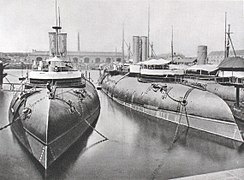
Cerbère and Bélier

Tonnant in 1890

Henri IV in 1910
See also[]
Citations[]
- ^ a b c d e f g h i j k l m n o p q r s t u v w x y z aa ab ac ad ae af ag ah ai aj ak al am an ao ap aq ar as at au av aw ax ay az ba bb bc bd be bf bg bh bi bj bk bl bm bn bo bp bq br bs bt bu bv bw bx by bz ca cb cc cd ce cf cg ch ci cj ck cl cm cn co cp cq cr cs ct cu cv cw cx cy cz da db dc Chesnau, Roger and Kolesnik, Eugene (Ed.) Conway's All the World's Fighting Ships, 1860–1905. Conway Maritime Press, 1979. ISBN 0-8317-0302-4
- ^ a b Brassey, Lord, The Naval Annual 1890, pub Griffin, 1890.
- ^ a b c d e f g "Ropp, Theodore, The Development of a Modern Navy, French Naval Policy 1871–1904, pub US Naval Institute, 1987, ISBN 0-87021-141-2
- ^ Hovgaard, William, Modern History of Warships, originally published 1920, pub Conway, 1978, ISBN 0-85177-040-1
- ^ Brassey, Lord, The Naval Annual 1887, pub Griffin, 1887.
- ^ Brassey, Lord, The Naval Annual 1886, pub Griffin, 1886.
- ^ a b Page 86, Brassey, Lord, The Naval Annual 1886,
- ^ Described as one of the first battleships to utilize turrets in superfiring mode
- ^ In 1920, Henri IV became a TSF school-ship (French: navire-école)
- Lists of ships of France
- Lists of ironclad warships































